Conversion Rate Optimization Blog
Practical tips to boost your site conversions.
5 of the Best eCommerce Marketing Strategies to Explode Your Sales
It’s a popular question.
What’s the best eCommerce marketing strategy? Which one should I be using for my eCommerce store? Which one will work for me?
It’s asked all the time:

Writing a post claiming I know the definitive answer would be wrong.
After all, there is no such thing as “best”. One person’s meat is another one’s poison. One person’s best marketing strategy is another person’s epic disaster.
Whether an eCommerce marketing strategy works for you depends on your context. It depends on your industry, what you sell, what your potential customers are used to, and in some cases, what regulations prevent you from marketing in a certain manner.
But, despite the “uncertainty”, all is not lost.
19 Ways to Reduce Cart Abandonment & Grow Your Revenue

Did you know that nearly 70% of shoppers abandon their carts and will NEVER return to complete their purchase?
Learn how to recover those lost sales and unlock the highest revenue from your eCommerce site!
Learn how to recover those lost sales and unlock the highest revenue from your eCommerce site!
While it is true that you’ll have to experiment to find the right marketing strategy, there are certain strategies that are “timeless”.
These are strategies that have been proven to work for many eCommerce companies in the past, and will continue to work foreseeably in the future.
These are the eCommerce marketing strategies I will be going through in this post.
Ready?
Let’s move on.
1. Content Marketing
No matter whether you’re ooh-ing over the latest BuzzFeed post, laughing at a GIF you found on Twitter, or seriously contemplating about your life after a mindblowing personal development article, the Internet IS content.
Which means: to market on the Internet, you’ll need content.
But, what exactly is content marketing?
Content marketing is the process of creating online material (e.g blog posts, videos, infographics, GIFs, images, etc.) that attracts your target audience. It is not used for selling directly, but as a way to educate potential customers about your product(s), develop thought leadership and raise awareness about your brand.
Many eCommerce companies have succeeded with content marketing. Take a look at Beardbrand:
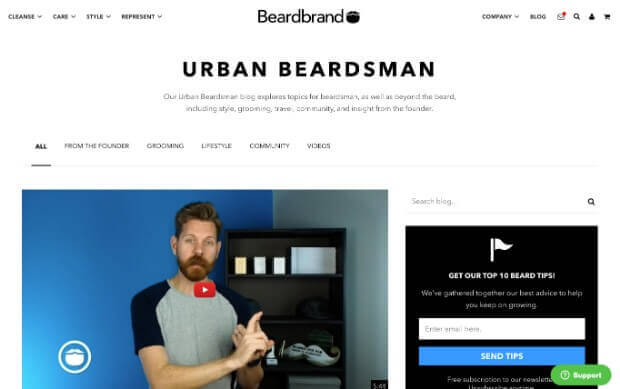
Beardbrand has a blog named “Urban Beardsman” that targets, well, beardsman – people who take pride in grooming their beards.
With their blog, they cover beardsmen-related topics:
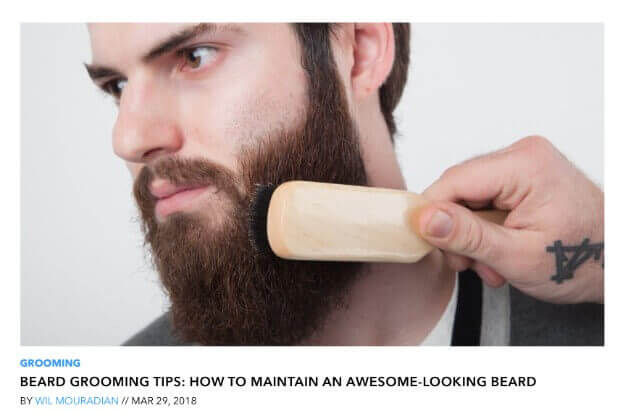
As founder and CEO Eric Bandholz puts it:
We learned that we are very good at uniting a community, at developing industry-leading grooming products, at setting clear guidance for how to use those the products, and providing the tools & inspiration to help men keep on growing beyond the beard.
If you take a look at the blog posts on Beardbrand, you’ll find that these are not short, 500-word articles. In fact, it’s quite the opposite. These are long, in-depth guides on beard grooming and beard lifestyle.
It’s well-researched, and shows the depth of knowledge the Beardbrand team has on how to live a life of a beardsman.
Not only are these long articles helpful, they also provide Beardbrand a chance to promote their own products in the article.
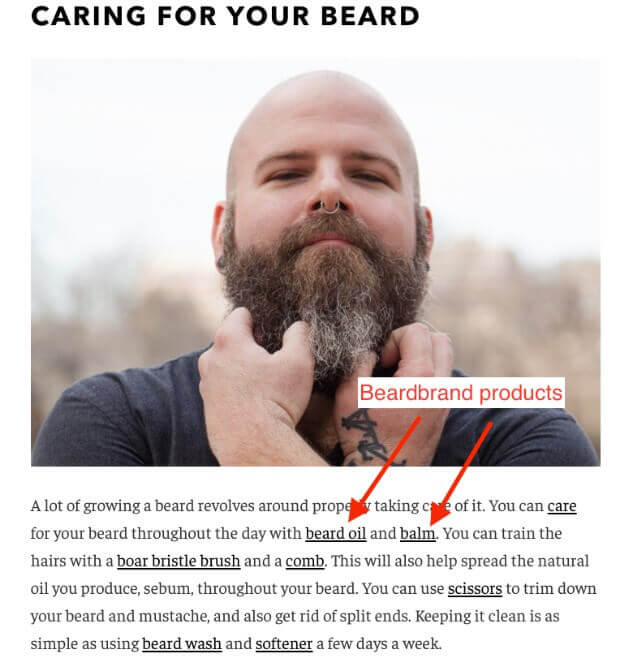
The result? Hundreds of thousands of visitors, and probably thousands in sales.

However, content marketing doesn’t just mean writing in-depth blog posts. As previously mentioned, content marketing is any online material meant for education.
That means videos are part of the mix too.
For that, we can take a look at one of the most successful eCommerce video channels – Luxy Hair.
The Luxy Hair YouTube channel has over 400 videos teaching their fans how to style, wear and care for their hair and extensions.
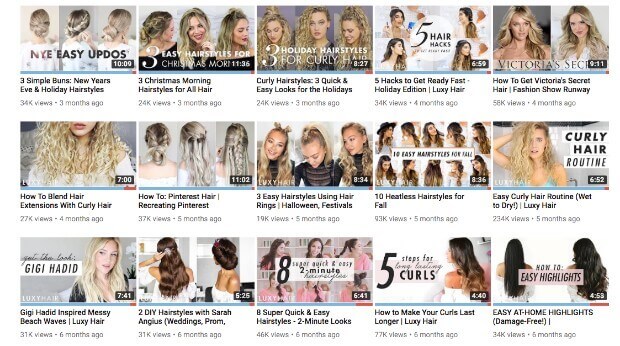
Like Beardbrand, these are in-depth videos ranging from 3 – 10+ minutes teaching their viewers how to best care for their hair. Some of their videos have received over 20 million views.
These tutorials have become a great marketing channel for Luxy Hair, both as a way to generate traffic, while also building up their brand as a thought leader in the hair products market.
Of course, these videos are a great opportunity for Luxy Hair to plug their own products, as seen here:
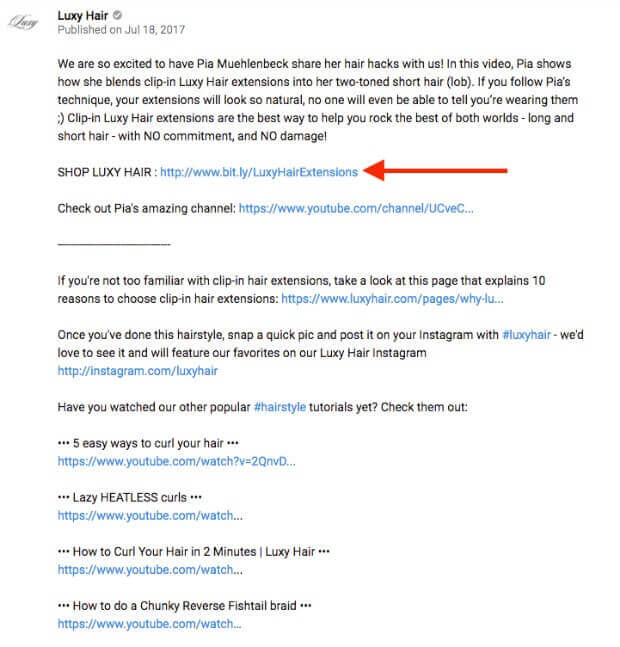
The result? A 7-figure eCommerce brand.
How To Apply It To Your Business
One of the biggest reasons content marketing works so well as an eCommerce marketing strategy is because Google loves content. In fact, content is one of the three biggest ranking factors.
That means producing content allows you to rank in Google, which in turn can send you traffic on autopilot.
And that applies similarly to videos as well.
Remember: YouTube is a search engine, and YouTube is also a Google product. That means videos on YouTube also have a chance of ranking on Google for relevant search terms.

This translates to mean – you need to create content for topics that have search demand.
You do that by looking for keywords that have enough search volume for you to tackle. (By the way, “enough search volume” is relative. To some people, 100 searches/month is enough, and for some, only keywords with 1000 searches/month is worth attacking. Make the definition yourself, and stick to it.)
To begin, think of a word or phrase that best represents what you’re selling. So, if you’re Beardbrand, it might be “beards”. For a yoga apparel store, it might be “yoga”, or “yoga pants”.
Enter the keyword into a keyword research tool, like Ahrefs Keyword Explorer and hit all:
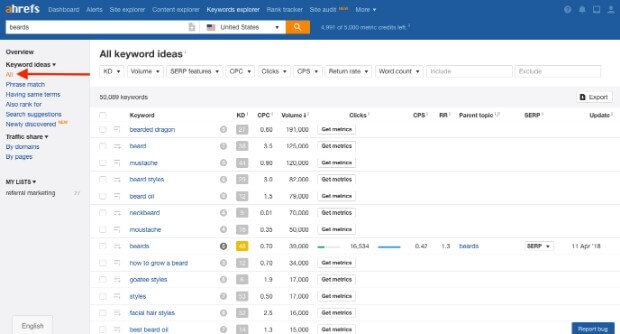
In this specific example, using the keyword “beards”, Ahrefs has generated 50,000 over keywords!
That’s (theoretically) 50,000 content ideas you could possibly create. Of course, you will not be able to create 50,000 pieces of content in one day, so you’ll have to prioritize.
Prioritize by finding keywords with the highest search volume and the lowest keyword difficulty. For example, by doing some digging into the list provided, I found this keyword, “best beard products”.
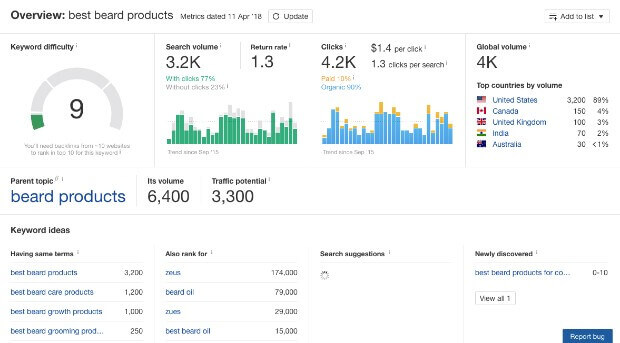
“Best beard products” has a pretty high search volume of 3,200 and a pretty low keyword difficulty of 9. Now, that’s a decent topic you could tackle on your blog!
File that away in a spreadsheet, and continue looking for more keyword ideas you could write for.
By the way, you can follow this research process for YouTube videos too. Ahrefs has a SERP Overview feature where you can see which posts are ranking for that keyword you want:
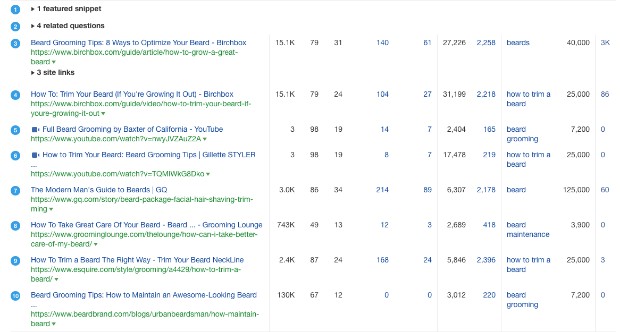
For example, under the keyword “how to groom a beard”, I can see that there are 2 YouTube videos ranking for this keyword. This means by creating a YouTube video, I have a chance of ranking for this search term!
Once you’ve a list of content ideas, it’s time to create content. Try to match the search intent as closely as possible. What would someone be looking for if they were typing this search term into Google or YouTube?
Of course, some keywords are obvious. Someone looking for “how to groom a beard” is looking for a how-to tutorial. Other topics, like “beard maintenance”, may be a little bit vague.
To help yourself, type the keyword into Google and have a look around what Google thinks. Consume the content ranking #1 – #10 and find the commonalities – this is likely to be the search intent.
Once you have that angle, beat the rest of the content. By that, I mean, find out how you can do better than the rest. What are the rest of the content lacking? How can you be different? How can you match the intent better?
Use the answers to those questions to create your content. Once done, distribute the content to your email list, your social media or to places where your potential customers hang out (like Facebook Groups).
Then, rinse and repeat.
Further Reading
- Keyword Research 101: How to Choose the Right Keywords for SEO
- How to Create a Successful Content Marketing Strategy in 11 Simple Steps
2. Referral Marketing
One of the most powerful (yet underrated) eCommerce marketing strategies is referral marketing (also known as word-of-mouth marketing).
The reason is simple – we’re all social creatures, and we love sharing our experiences with our family and friends. It benefits us too – we help each other avoid bad experiences, and encourage each other to support places that provide an excellent experience.
That also means, whether you like or not, people are going to share about you with their friends. Wouldn’t you prefer that sharing be something positive about your brand and product?
That’s referral marketing.
Referral marketing is when you deliberately influence the process of word-of-mouth, whether it is encouraging more sharing, or positioning the sharing to be positive.
Referral marketing is the secret weapon of many eCommerce companies. Take for example, Acton Global:
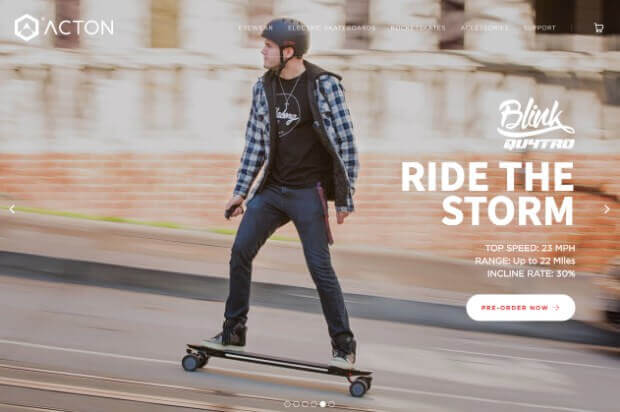
Acton Global is the company behind RocketSkates, the first ever smart, electric skates. Since then, they’ve become one of the leading companies in making and popularizing smart, personal transportation (like electric skateboards.)
Not many people know this, but Acton got its start from a successful Kickstarter campaign:
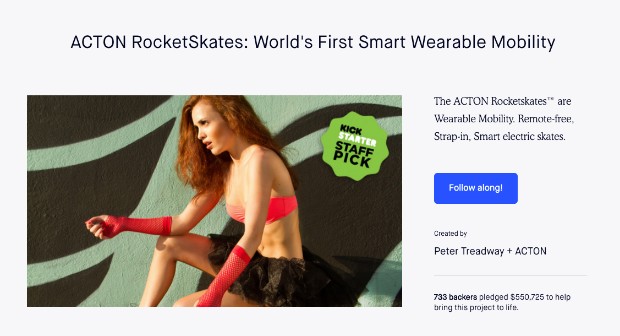
But we all know many Kickstarter campaigns don’t end well. From Pebble to Coolest Cooler, they have all sputtered and disappeared.
How did Acton survive?
Through great products and a referral marketing program.
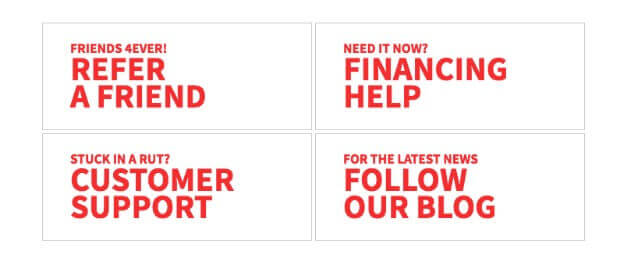
With a referral program in place, Acton gets hundreds of social shares a day, bringing tons of extra traffic and sales:

How To Apply It To Your Business
The fastest and easiest way to kickstart your referral marketing is to set up a referral program. If you have the resources (like Uber or Dropbox), you can hire a developer to custom design a referral program for your store.
This allows you to have full control over your referral program, but it may be tedious and resource-intensive.
The alternative is to install an referral program app, like ReferralCandy. A referral app allows you to get started quickly, as everything is (almost) done-for-you.
No matter which solution you choose, there are several components of a referral program you must get right in order to ensure that this eCommerce marketing strategy will work for you.
First, your incentives.
This is important as this is the primaryreason why your customers will share. After all, a referral program helps to influence the referral process by providing incentives.
Thus, giving the right incentive is almost the entire battle won.
The “right incentive” depends entirely on your context – what your store is, what industry, what products you sell, your pricing and what your competitors have done.
All is not lost, of course. There are a few “rule-of-thumbs” you can follow.
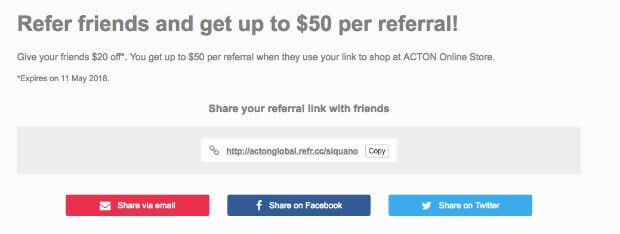
If you’re selling something people need frequently, give a discount coupon. If you’re selling a product that most people only buy once, give a cash incentive (after all, your customers have no need for a “Get 20% off your next purchase” type of deal.)
After you’ve successfully decided on an incentive, the next thing you should get right is your promotion.
If you do not promote your referral program, nobody will know of it. And if no one knows, no one will join… and your program will fail.
Promote your referral program as much as you can. Treat it like a product launch. Share it on your social media, and send it to your email list. Invite all of your past customers to join your referral program.
Add a link to your referral program in your footer:

Do all you can to promote your referral program, and let people know about it.
Further Reading:
- How Referral Programs Can Encourage Customers To Do Your Marketing For You
- Referral Program Examples – An Epic List of 74 Referral Programs
Looking for another way to leverage social proof? Check out TrustPulse! With TrustPulse, you can instantly increase trust, conversions, and sales by up to 15% using real-time site activity.
3. Email Marketing
Who still reads emails?
Everyone.
Despite the popularity of social media and chat apps, email still remains the #1 communication channel for many. 91% of consumers check their email on a daily basis.
That means email can be your most profitable channel. The stats suggest so too.
Email marketing has found to have an ROI of 3800%. The average order value of email marketing is 3X higher than social media.
People spend 138% more when marketed via email (as compared to those who don’t.)
So, what exactly is email marketing?
At its very core, email marketing is simply sending promotional emails to people have given you permission.
You can send all sorts of emails to your prospects and customers. For example, you can send an email urging your customers to take advantage of some exclusive, time-sensitive discount, like Huckberry:
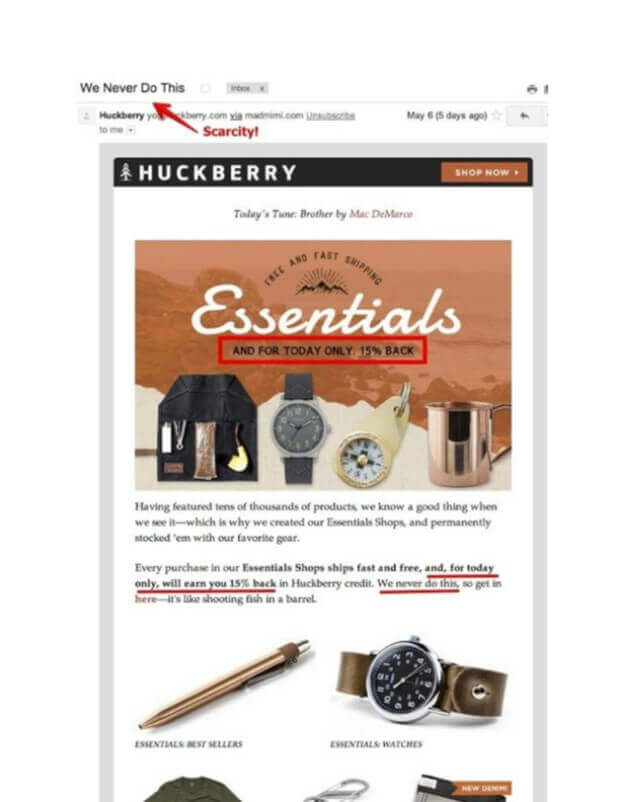
Emails to encourage people to browse your products, like J.Crew:
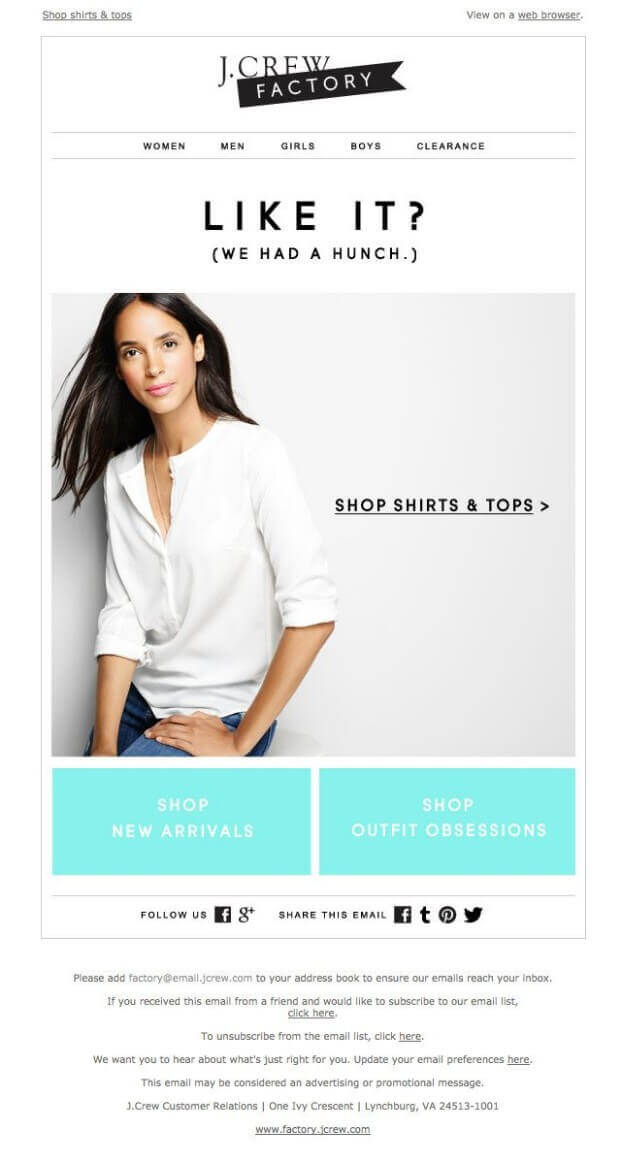
Why not send an email to catch people who’ve filled their carts, but abandoned it last minute? Here’s an example from Urban Outfitters:
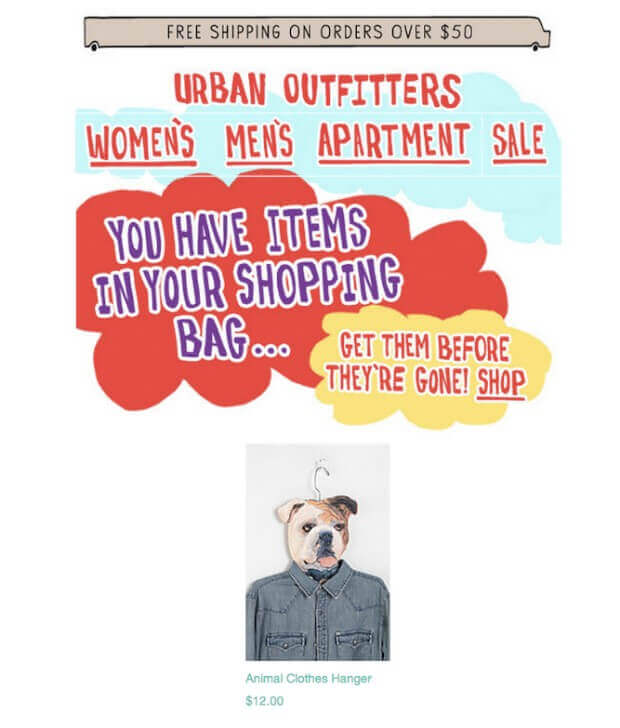
As you can see, there are plenty of things you can do with email marketing. Your options are endless.
How To Apply It To Your Business
There are two main parts to email marketing:
- Building your email list
- Sending the right emails
Of course, before you even begin sending your emails, you’ll have to build your email list. Without a list, you’ll have no one to send emails to.
How do you build your list?
To begin, you must have an attractive offer. You need to help your potential customers answer, “what’s in it for me?”
Everyone hates spam. To get them to sign up, you must entice them by providing something valuable.
The specific offer depends on your store, but there are several things you can experiment with to see if they work.
The first thing you can try is to offer a discount to encourage them to sign up for your list. Here’s an example from Greats:
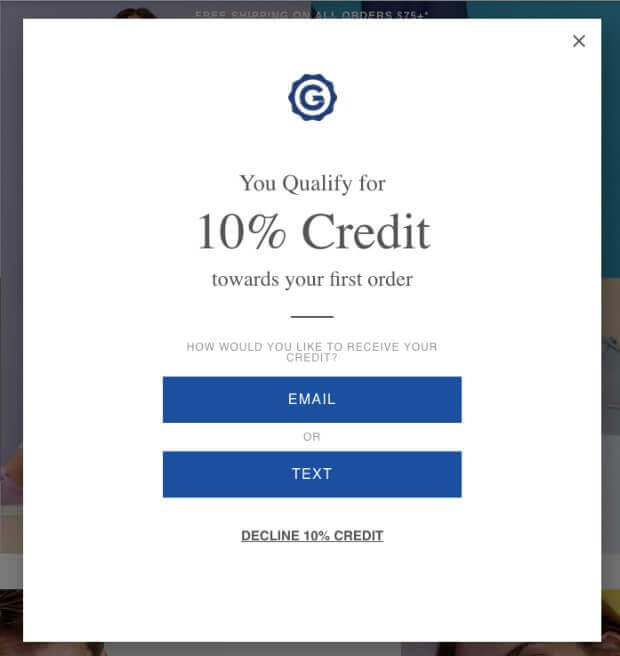
The second type of offer you can test is a lead magnet. A lead magnet is a “bribe” offering some specific value in exchange for their contact information.
A lead magnet can come in the form of a ebook, guide, cheat sheet, etc.
Here’s an example from The Eczema Company. The Eczema Company is an online store that sells natural skin care, protective clothing and alternative laundry products for people suffering from eczema. This was the lead magnet she offered:

This ebook converted at about 3.89%. That’s quite a significant number!
Once you have your offer, you’ll need a way to show it to your visitors.
To do this, use an app like OptinMonster. Apps like OptinMonster allow you to display your offer prominently on your site through various mechanisms, like timed pop-ups (pop-ups that appear after a fixed time), exit-intent pop-ups (pop-ups that appear when OptinMonster detects that the visitor is leaving), and percentage-scroll boxes (slide-in popups that appear when a visitor has scrolled a certain percentage of the page).
This allows your website to build your email list, even if you’re not tending to it!
Once you’ve gotten your list building on autopilot, it’s time to send the right emails. Of course, you can make this as complex as possible, but make sure you fix your fundamentals by sending these emails.
You should be sending:
- Welcome Email – this is an email that your subscribers will receive when they first join your list
- Email Nurture series – this is a sequence of emails you send to educate your customers about your product, your brand or your niche
- Cart Abandonment email – this is the email you send when your visitors fill up the cart, then leave your store without checking out
- Email Receipts – these are emails you send to confirm your customer’s purchase; it’s also a great time to send them further promotions!
Once you have these emails set up, then you can play around with the different kinds of emails.
Whatever it is, the world’s your oyster.
Further Reading
- 9 Simple eCommerce Email Marketing Tips to Skyrocket Your Sales
- 7 Automated Email Campaigns That Win Customers and Keep Them Coming Back
4. Instagram Marketing
Did you know?
65% of Instagram users use their feed to look for online shopping inspiration, while also looking to discover new brands. These are users who are looking for stores like you to purchase from!
This also means that if you do not have a solid Instagram presence, you’re missing out on tons of sales.
And this is especially so if you’re selling products that are highly visual in nature. Let’s take for example Monday Swimwear:
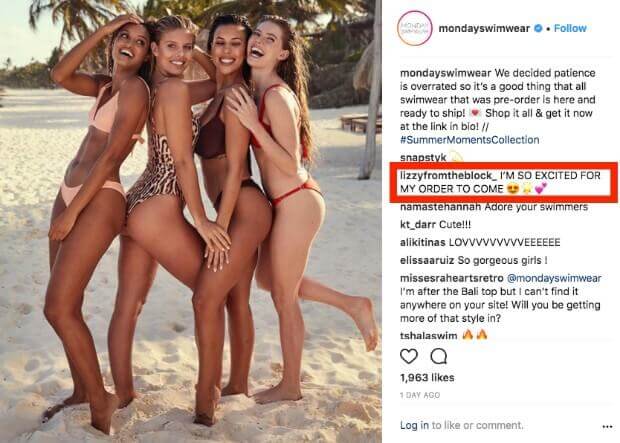
Monday Swimwear is a swimwear brand started by two influencers, Natasha Oakley and Devin Brugman.
Bikinis are obviously highly visual products. No matter how captivating the copy, potential customers have to browse the different bikini designs to decide whether to purchase one for themselves.
Monday Swimwear understands this. This explains why the founders have spent so much time building up their Instagram following:

At 301,000 followers, the Monday Swimwear account sends thousands of visitors to their website.

Their Instagram account serves like an online catalog, allowing them to feature specific bikinis in their collection. This obviously entices customers to check out their products, and later on, purchase:
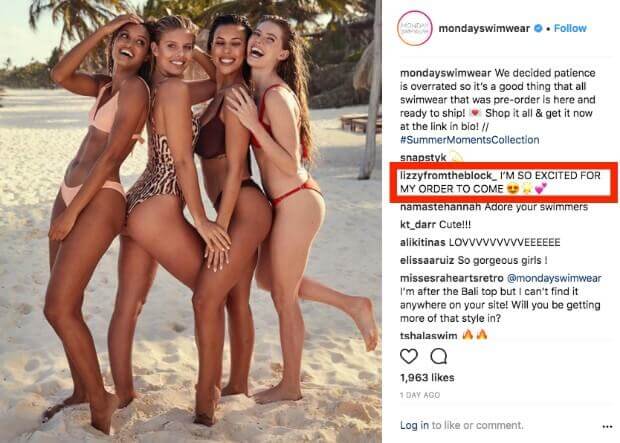
How To Apply It To Your Business
Despite what many people believe, Instagram is not a set-it-and-forget-it marketing channel.
You’ll need to nurture your Instagram followers, keeping them engaged while also encouraging them to purchase.
To do well on Instagram, you’ll have to focus on three pillars:
- Create quality content
- Get more followers
- Engage with your audience
Needless to say, as a visual medium, quality images are the foundation of your Instagram account. You’ll have to create photos or images that are high-quality, and show off your products in a natural manner.
Don’t skimp on this aspect! If you have to, engage a professional photographer. Content will be one of the biggest reasons why you have followers, and why they stay.
Research your target audience and find out what kind of images they engage with. Monday Swimwear knows that their audience loves bikinis and the beach life, so they include lots of photos of them showing off their bikinis at the beach:

Then, make sure you post on your account consistently. Nathan Chan, the CEO of Foundr Magazine, says you’ll have to post at least 3x a day.
While the backbone of your account, quality content will not grow your account exponentially. To build your following, you’ll have to be proactive.
There are two main tactics you can use to build your following fast. One, run a giveaway.
Giveaways work because it is viral in nature. Everyone wants to win something for free.
To set up the giveaway campaign properly, make sure the competition rules are such that participants have to follow your account and tag their friends. If you do this correctly, you should be getting tons of new followers who are interested in what you have to offer!
Here’s an example of a giveaway hosted by Monday Swimwear:

The second tactic is getting influencers to promote your account for you. Influencers are people who have built a massive following on social media. By partnering with these influencers, you can funnel their followers into your followers.
Here’s an example of Monday Swimwear working with Cara Jourdan, an influencer with 228,000 followers:

By tagging Monday Swimwear in a post, Cara’s followers also learn of the brand, and eventually follow the Monday Swimwear account.
There are many ways of working with influencers, and it will eventually be up to you to decide on how to work with them.
With quality content, giveaways and influencer collaborations, you should have a healthy, growing account. That doesn’t mean the work is over.
Just like with any social media, you’ll have to engage with your followers, and show that you care. This means that you’ll often have to dive into the comments and answer relevant questions.

Despite having a massive account, Monday Swimwear still reaches out to their potential customers. I’ll bet that Erica converted to a customer once she fixes her sizing problems.
Further Reading
- [Shopify Instagram Marketing] 5 Steps To More eCommerce Sales
- 5 Tactics To Grow Your Instagram Following and Increase Sales For Your Online Store
5. Facebook Ads
Despite the troubles facing Mr. Zuckerberg, Facebook still remains one of the most powerful advertising platforms available to marketers.
There is no other ad platform with this level of targeting. You can choose to target your ads based on location, age, language, education, life events, interests, behaviours, and so on.
You can even add a Facebook pixel on your website, and retarget people who have visited your website, but did not make a purchase.
Purple agrees.
A mattress company, Purple has generated millions of dollars in sales just by running Facebook ads.
Of course, it isn’t any ad.
It’s an ad specifically designed to go viral, boosted by the power of Facebook ads.
This only goes to show how powerful Facebook ads can be. It can be a channel for direct sales, or a supporting tactic for any of the above strategies (for e.g you can send traffic to your blog posts via Facebook ads).
How To Apply It To Your Business
There is no “best” way of running Facebook ads. The best method is dependent on a variety of factors (e.g your industry, your audience, your offer, etc.)
The “best ads” are often discovered through pure experimentation.
The first step to setting up a successful Facebook ad campaign is to decide which product(s) you want to sell. This is your “offer”. As discussed in the email marketing segment, your “offer” helps your audience answer the question, “what’s in it for me?”
In the above example, Purple decided to only focus on one product, the Purple Mattress Protector. This helps simplify their message as Purple only has to market one product.

Simplicity = sales.
Once you’ve decided on which product(s) you want to show in your ad, you should decide on which audience this product is good for.
You probably have different products catering to different subsets of people. There is no point in trying to sell your product to those who are uninterested.
(This is also the reason why Facebook ads are so powerful, as it allows you to drill down in detail on which audiences you want to serve.)
In the Purple example, it is obvious that the ad is targeted at mothers.

With your product and audience selected, it’s time to craft the ad. Outstanding imagery is important for Facebook ads. This is because ads are shown when your audience is scrolling through their News Feed.
Whether a video or an image, it needs to stand out and capture the attention of a user who is busy scrolling. Your ad needs to “disrupt” their attention.
Purple understands that.
A sasquatch selling mattress protectors is inherently curiosity-inducing. People scrolling through their Facebook feed will pause to take a second look.

Once that is done, add some compelling copy to the ad and begin running it. Observe it for a week or two and measure the results.
Double down on the budget if it is working, and stop the ad if it isn’t.
Of course, you shouldn’t just run one ad and hope for the best. Paid advertising is all about experimenting.
Run multiple ads with different variations so you can find the best-converting ones for your business.
Then, rinse and repeat. Keep testing to find the best ad, and keep refreshing your ads so your audience doesn’t develop ad blindness.
Further Reading
- How To Optimize Your Facebook Ads To Skyrocket Your Conversions
- 7 Must-Use Facebook Ad Strategies For eCommerce Marketers
Final Thoughts on eCommerce Marketing
There is no such thing as a universal “best strategy”.
However, there are timeless strategies that have been proven to work by many eCommerce stores before you.
Run through the list of strategies I’ve suggested, decide on one, and test it out.
If it works, double down on it. If it doesn’t try another.
You will eventually discover the best eCommerce marketing strategies that will work for your store.
Next, check out our guide to creating an eCommerce business plan, and our ultimate guide to eCommerce optimization to make sure you’re making the most of your increased traffic!

12 Proven Ways to Convert Abandoning Visitors into Subscribers
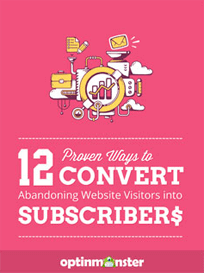
Over 70% of visitors who abandon your website will never return!
Learn how to unlock the highest conversion revenue from each of your website visitors!
DOWNLOAD NOW




President of OptinMonster